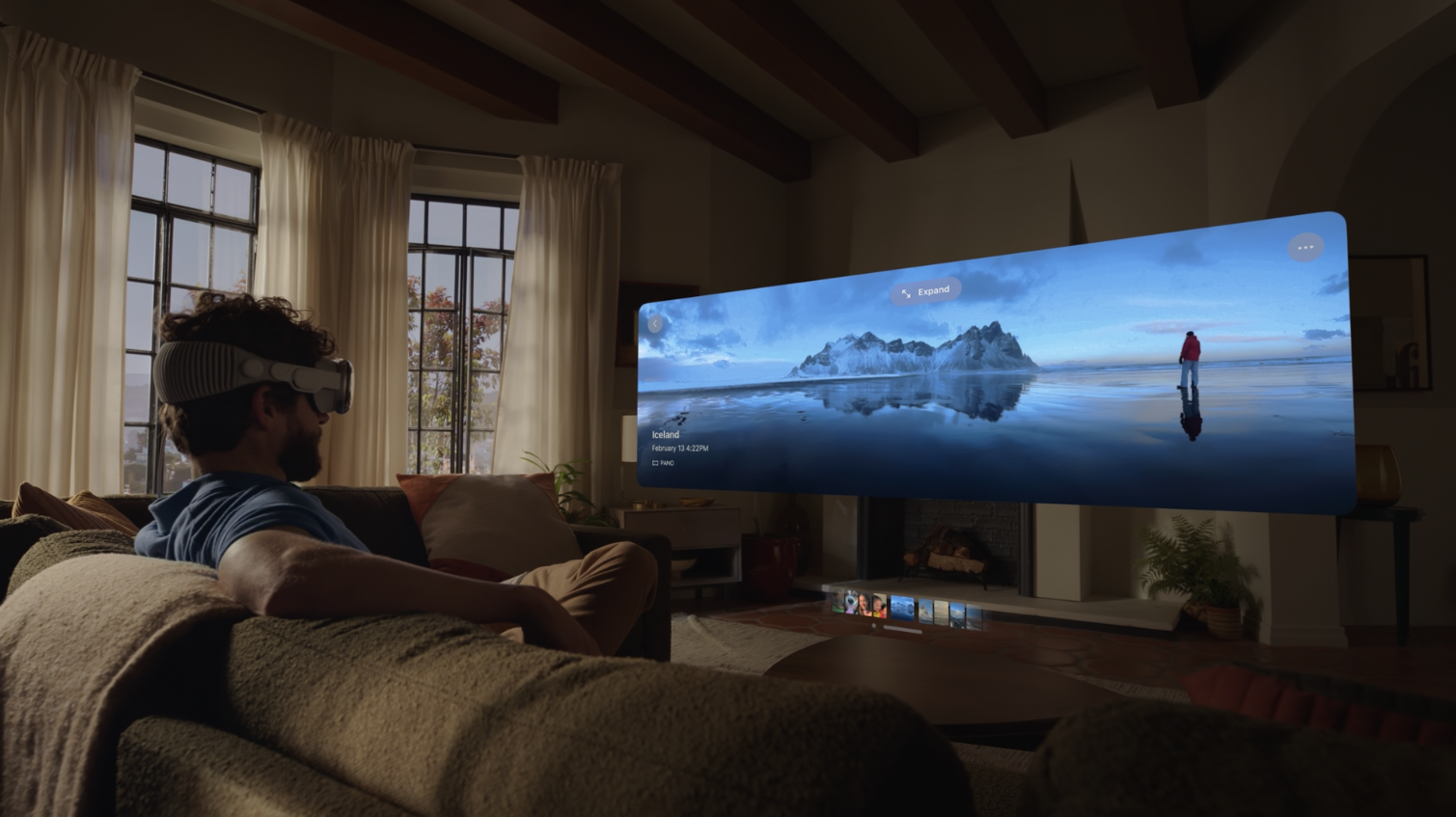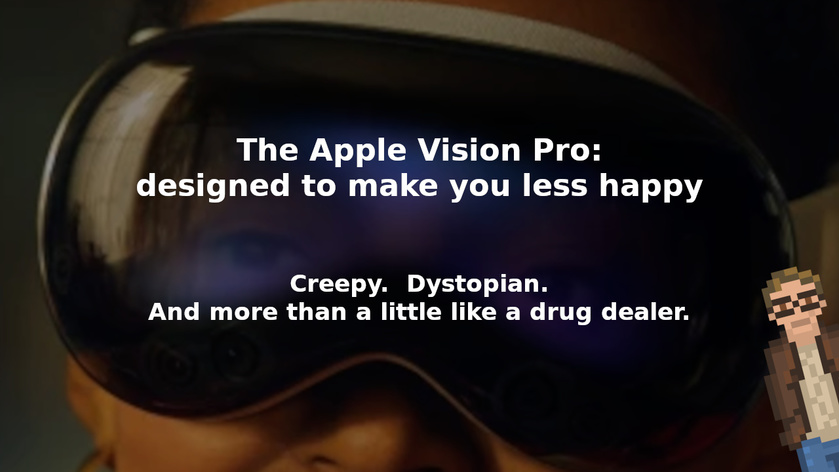The Apple Vision Pro is a truly remarkable feat of engineering. Both the hardware and software of this, undeniably, revolutionary device are nothing short of phenomenal. I stand in awe of the technical wizardry on display by the team at Apple.
That said.
It is crystal clear that the Apple Vision Pro will make those who use it less happy.
And this is not a bug. This is not a flaw that needs to be ironed out. The fact that the Apple Vision Pro will make people sad is core to the very design of the device itself.
The fact that Apple will benefit from the sadness of its users, suggests -- rather strongly -- that this is not an accident.
Allow me to explain.
Apple Vision Pro takes away your eyes
When you strap the Apple Vision Pro onto your face -- which Apple is encouraging you to do "all day", even while talking with other people -- no other human can see your eyes.
The eyes are a gateway to the human soul. Not being able to see the eyes of the person you are talking to takes away a core part of the experience.
In fact, the Vision Pro doesn't simply cover up your eyes... it displays a "Deep Fake", 3D rendered representation of what your eyes might look like to the screen on the outside of the Vision Pro.

Is it creepy?
Yes. Undeniably creepy. Disturbingly so.
But, even more importantly, it places a barrier between you and whoever you are talking to. Removing one core piece of the human experience. By design.
But Apple doesn't stop there. No, sir. That is only the beginning.
Apple removes YOU from video calls
The world of video conferencing has exploded over the last few years. For better or worse, many of us make an awful lot of video calls -- for both work and personal reasons.
And, while these video calls may not be as personal as being, you know, actually in front of another person... they still have the benefit of showing real video of the person you are talking to. You can see their eyes. Their facial experessions. You can see what they really look like.
A core feature of the Apple Vision Pro is to remove that video of you... and replace it with a 3D rendered Deep Fake of what you might look like.
Seriously.

Your face is covered by the Vision Pro, no video camera is there to capture your true face. So what does Apple send to those you are on a video call with? A terribly creepy -- and absolutely not real -- rendering of "you".
If you are on a video conference call with 3 other people -- and each of you is using the Vision Pro -- you now have 4 people... looking at not real, Deep Fakes of each other. Placing yet another barrier between you and all other humans.
Apple Vision Pro is designed to isolate you
You'll note that, in all of the features of the Vision Pro, Apple is providing functionality that is not entirely new. These are not new things we can do because of the Vision Pro... merely new ways of doing the things we already have been doing for our entire lives.
Case in point: Watching a movie.

Putting a movie on a big screen TV, sitting on the couch, and enjoying a bowl of popcorn with your family. Or your date. Or your friends.
That is a core experience of modern humanity. One which allows us to be together, to share experiences with those we love, and -- importantly -- truly be there.
But watching a movie in the Vision Pro -- which, according to Apple, was designed for exactly this usage -- means that, when you glance over at your date, you can't see her eyes. Nor can she see yours.
Everyone wearing the Vision Pro is in their own world. Isolated. Alone.
Apple provided, during their grand announcement of the Vision Pro, a number of other examples for how they expect you to utilise this ground breaking device.
Such as: Watching your children play.
/cdn.vox-cdn.com/uploads/chorus_asset/file/24705373/apple_vision_pro_screen_059.jpg)
Instead of playing with your kids -- and, possibly, holding a camera to take pictures or record some home movies of the occasion -- you are encouraged to strap the Vision Pro over your eyes... and watch.
The recorded video, Apple says, will be truly amazing.
So, later on, you will be able to enjoy the ultra-HD, spacial, 3D-ish video of you not playing with your kids.
You will marvel at the stunning picture of that time when you could have engaged in one of the core human activities... but, luckily, Apple helped you avoid that heart-warming time with your children.
Also, when your kids look up at you, they won't see your eyes. They will see a Deep Fake, dystopian rendering of what Daddy's eyes might look like.
Which definitely won't give your kids nightmares.
Vision Pro. All day. Even at work.
"But," I hear many of you saying. "You don't need to use the Vision Pro all the time! Just some times!"
That's not the way Apple is positioning it.
In fact, Apple repeatedly declared that their goal is to use the Vision Pro all day long. Playing with your kids. Watching movies. Playing video games. On video calls. Walking around outside.
And even at work.

Just the same.
Even if the usage of the Vision Pro is limited to no more than 2 hours per day... that's still two hours where you are that much more cut off from all of humanity -- both those in the same room as you, and those are you on a video call with across the world.
Seeing Dad's eyes replaced with Deep Fake renderings, even for just a few hours, is already deeply disturbing.
This is some seriously dystopian future stuff here. This is the type of technology that oh-so-many Sci-Fi stories warned us about. Where technology -- advanced and impressive -- would cut us off from those around us.
Groups of people, sitting together, but not actually together. Separated by the high tech wizardry strapped to their faces.
Each person, becoming increasingly sad... increasing unsatisfied with their life. Yearning for any small hit of Dopamine they can get -- from a virtual "reward" or "trophy". From a person sending them a digital "sticker". From purchasing additional features, games, videos, and other consumables.
All in an endless quest to find some sense of happiness that would be found... by simply removing the device on their face.
Who benefits from this sadness? Apple.
Make people sad, then charge them to get small doses of happiness.
This is not a new business strategy.
Facebook, Twitter, and other mass-Social Medial services have exploited exactly this model for years. And where did they learn it? From drug dealers.
Apple is merely the latest company to recognize the vast profits possible by making people sad, hooking them on the very source of the sadness (which will give them little doses of artificial happiness), and then charging them for it.
Subscriptions to Apple services. Purchases on the new Apple Vision App Store. Purchasing of additional Vision Pro's (and other Apple devices) so that those around you can "enjoy it with you".
Just like drug dealers.
Side note: I also discuss this problem in the latest episode of Lunduke's Big Tech Show.














